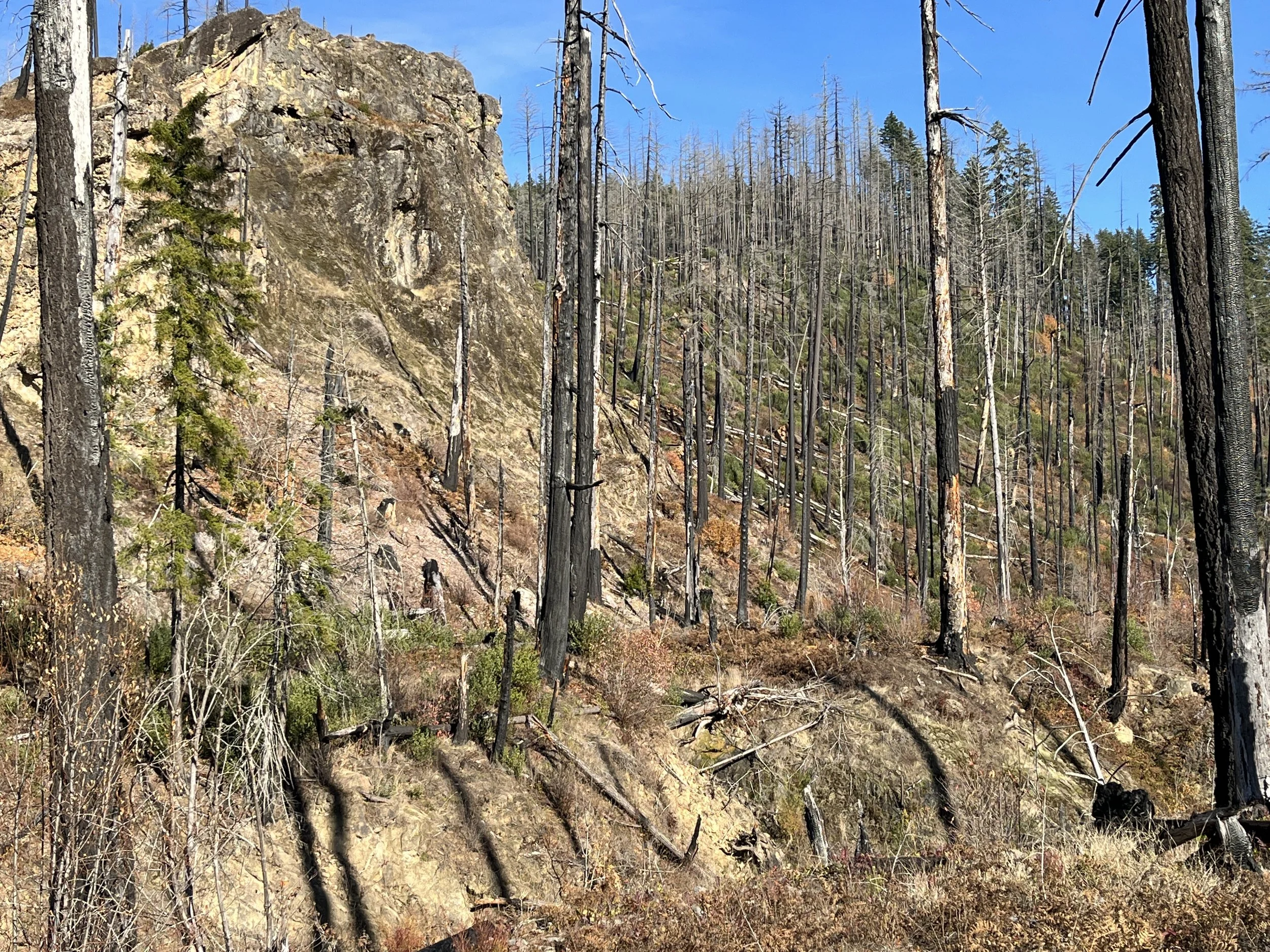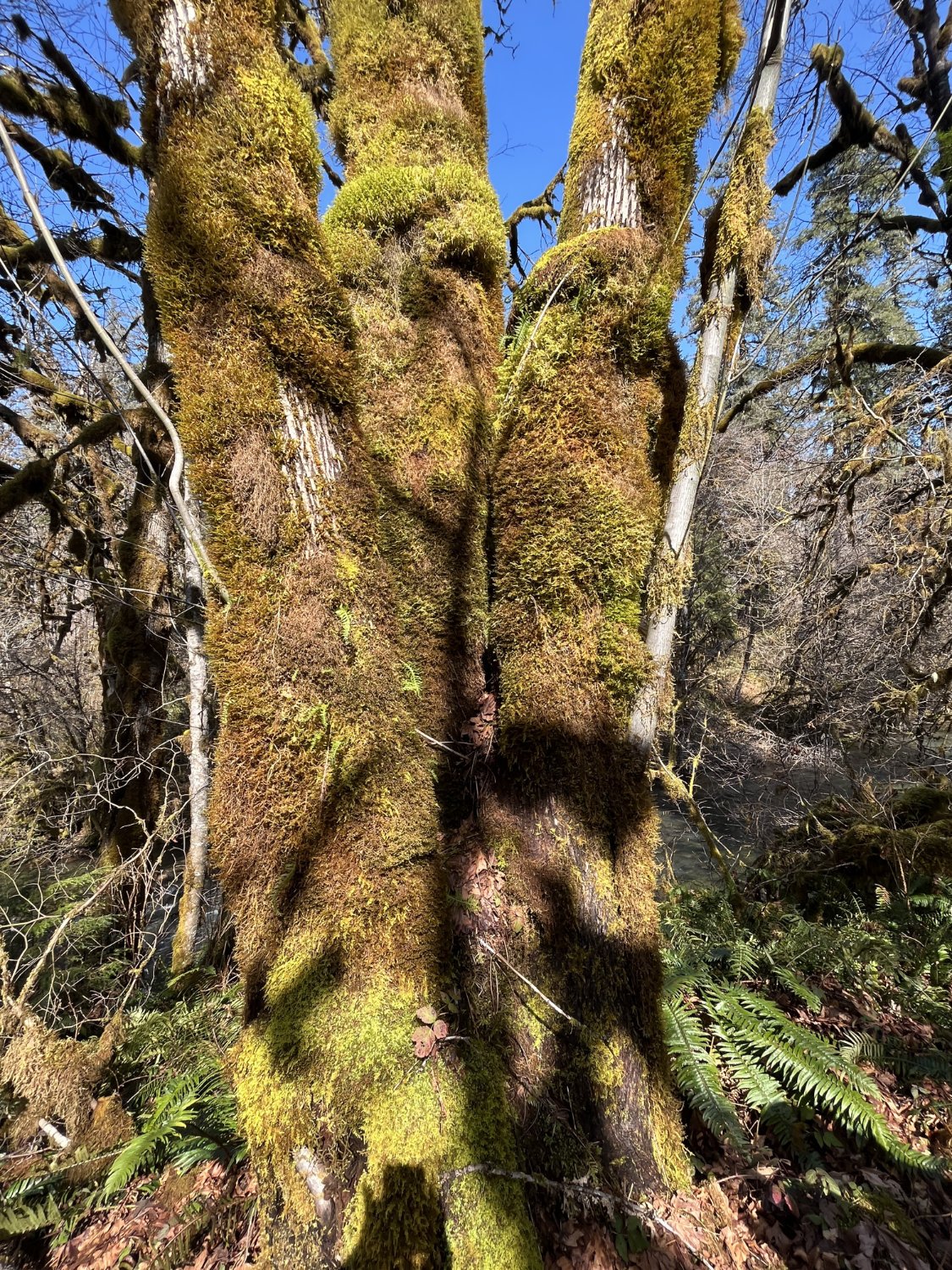
30. Fall Creek
Summary
Length 3 miles one-way (lower segment)
Difficulty Easy to moderate
Season Early-spring to late-autumn
Elevation range 900 feet – 1,080 feet
Human imprint High (nearby roads and campgrounds; high use)
Information Willamette National Forest, Middle Fork Ranger District
Primary old growth features
Once abundant riparian old growth heavily impacted by multiple wildfires.
Description
Classic low-elevation old growth once lined the Fall Creek National Recreation Trail for almost its entire 14-mile length, and the trail has long been popular with forest and stream lovers. Recent wildfires have dramatically reshaped the landscape, however, leaving behind a vast snag forest. Historically, old-growth forests were also steadily eliminated by logging in Fall Creek following World War II up until approximately 1990, but old forests near the trail were largely spared. In fact, there was enough old forest left that the upper watershed was designated as a Late-Successional Reserve in the Northwest Forest Plan in 1994 as part of a regional strategy to protect old forests and the species that depend on them.
The 21st century ushered in a new reality for Fall Creek. First, the human-caused Clark Fire (2003) burned almost 5,000 acres, foreshadowing future events. In 2017, the lightning-ignited Jones Fire burned over 10,000 acres, reburning much of the Clark Fire footprint. Next came the Gales Fire (2021), also lightning ignited, burning almost 32,000 acres covering most of the upper watershed. And then the human-caused Bedrock Fire (also approximately 32,000 acres, 2023) completed the action torching most of the lower watershed and burning up to the Gales Fire. In the process, the Bedrock Fire reburned the Jones Fire and Clark Fire areas, meaning that some locations have burned three times over a 20-year period.
The trail splits naturally into three segments, each formerly dominated by beautiful, riparian old growth. Only the lower trail segment now traverses unburned old forest, however, and is highlighted here. The lower section starts at the westernmost trailhead just before crossing the bridge at Dolly Varden Campground. This three-mile section closely parallels Fall Creek and FR 18, both of which are often within eyesight and earshot.
Heading eastward on the south bank of Fall Creek, the first ¾ mile is fire-free. Luxuriant, streamside forest features mossy maples and large Douglas-fir, most approximately 250 years old. Occasional, much-older and larger Douglas-fir veterans are close to 500 years old. The forest in this area experienced significant snowdown (treefall and branch breakage from heavy snow loads) from “Snowmageddon” in February 2019, producing a more open upper forest canopy and an understory happy with more sunlight. The trail then enters the burn area, and continues in the burn until rejoining FR 18. The first mile or so retains some surviving thick-barked Douglas-fir, but the last mile has very high mortality.
I recommend this hike both as a beautiful streamside walk in the woods, and for instructive insight into the effects of fire in an old-growth forest. The middle and upper trail segments have been heavily affected by the fires with few surviving old trees, and may be very challenging to hike. Drive FR 18 up to the end of the trail at FR 1833 to appreciate the scale and severity of the Fall Creek fires. There is a small area that was salvage logged following the Clark Fire around FR 1821, and a section of private land further upstream, but most of what you see from the road resulted from the fires.
30 years of change
Almost the entire length of trail has been heavily impacted by multiple 21st century wildfires (Clark, Jones, Gales and Bedrock Fires) including large areas of high severity fire. Heavy snow in 2019 caused extensive treefall and opened up the canopy in the lower segment.
How to get there
Turn left (north) towards Lowell off of State Route 58 at the covered bridge, 20 miles southeast of Eugene. Continue through Lowell, turning left then right, and come to a four-way stop by another covered bridge 2.5 miles later. Turn right on County Road 6204 (which becomes FR 18 at the national forest boundary) and follow it for about 10.25 miles to the main trailhead for the lower segment. Park on the right just before crossing a bridge by the Dolly Varden Campground.

Upper Fall Creek

Big Doug-fir

Slick Creek bridge, after the Jones Fire (2018) but prior to the Bedrock Fire (2023)

Post Clark Creek Fire

Mossy maple

Western redcedar & Douglas-fir
